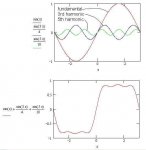Most people don’t spend a lot of time worrying about the resonator bars in a Glockenspiel, Mike. Only Glockenspiel designers would.
The same is true for rotors. Most likely, the only person, if any, to have thought about Magni rotor resonances was Jukka Tervamaki.
Your lower sketch is the one.
The same is true for rotors. Most likely, the only person, if any, to have thought about Magni rotor resonances was Jukka Tervamaki.
Your lower sketch is the one.


